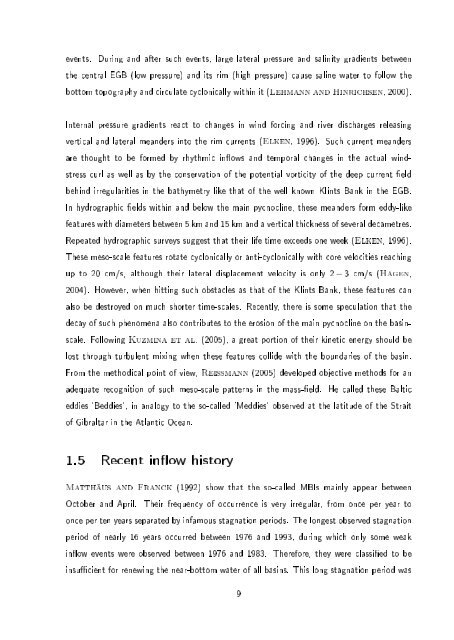Baltic Sea
Baltic Sea
Baltic Sea
You also want an ePaper? Increase the reach of your titles
YUMPU automatically turns print PDFs into web optimized ePapers that Google loves.
events. During and after such events, large lateral pressure and salinity gradients between<br />
the central EGB (low pressure) and its rim (high pressure) cause saline water to follow the<br />
bottom topography and circulate cyclonically within it (Lehmann and Hinrichsen, 2000).<br />
Internal pressure gradients react to changes in wind forcing and river discharges releasing<br />
vertical and lateral meanders into the rim currents (Elken, 1996). Such current meanders<br />
are thought to be formed by rhythmic inows and temporal changes in the actual windstress<br />
curl as well as by the conservation of the potential vorticity of the deep current eld<br />
behind irregularities in the bathymetry like that of the well known Klints Bank in the EGB.<br />
In hydrographic elds within and below the main pycnocline, these meanders form eddy-like<br />
features with diameters between 5 km and 15 km and a vertical thickness of several decametres.<br />
Repeated hydrographic surveys suggest that their life time exceeds one week (Elken, 1996).<br />
These meso-scale features rotate cyclonically or anti-cyclonically with core velocities reaching<br />
up to 20 cm/s, although their lateral displacement velocity is only 2 − 3 cm/s (Hagen,<br />
2004). However, when hitting such obstacles as that of the Klints Bank, these features can<br />
also be destroyed on much shorter time-scales. Recently, there is some speculation that the<br />
decay of such phenomena also contributes to the erosion of the main pycnocline on the basinscale.<br />
Following Kuzmina et al. (2005), a great portion of their kinetic energy should be<br />
lost through turbulent mixing when these features collide with the boundaries of the basin.<br />
From the methodical point of view, Reiÿmann (2005) developed objective methods for an<br />
adequate recognition of such meso-scale patterns in the mass-eld. He called these <strong>Baltic</strong><br />
eddies 'Beddies', in analogy to the so-called 'Meddies' observed at the latitude of the Strait<br />
of Gibraltar in the Atlantic Ocean.<br />
1.5 Recent inow history<br />
Matthäus and Franck (1992) show that the so-called MBIs mainly appear between<br />
October and April. Their frequency of occurrence is very irregular, from once per year to<br />
once per ten years separated by infamous stagnation periods. The longest observed stagnation<br />
period of nearly 16 years occurred between 1976 and 1993, during which only some weak<br />
inow events were observed between 1976 and 1983. Therefore, they were classied to be<br />
insucient for renewing the near-bottom water of all basins. This long stagnation period was<br />
9



